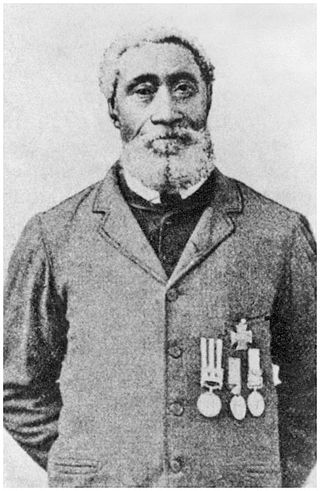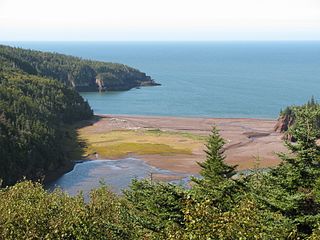
Hants County is a historical county and census division of Nova Scotia, Canada. Local government is provided by the West Hants Regional Municipality, and the Municipality of the District of East Hants.

Sackville is a former town in southeastern New Brunswick, Canada. It held town status prior to 2023 and is now part of the town of Tantramar.
Windsor is a community located in Hants County, Nova Scotia, Canada. It is a service centre for the western part of the county and is situated on Highway 101.

William Nelson Edward Hall was the first Black person, first Nova Scotian, and due to his actions in the 1857 Siege of Lucknow, he was the third Canadian to receive the Victoria Cross. He received the medal for his actions during the Indian Rebellion. During the action in which the naval gun crew with which he was serving came under heavy fire as they attacked a mosque. Hall and an officer from his ship continued to load and fire a 24-pounder gun at the walls of the Shah Nujeef mosque after the rest of the party had been killed or injured by the local resistance hoping to secure the restoration of Mughal suzerainty.

The Minas Basin is an inlet of the Bay of Fundy and a sub-basin of the Fundy Basin located in Nova Scotia, Canada. It is known for its extremely high tides.
Hantsport is an unincorporated area in the West Hants Regional Municipality, Nova Scotia, Canada. It is at the western boundary between West Hants Regional Municipality and Kings County, along the west bank of the Avon River's tidal estuary. The community is best known for its former industries, including shipbuilding, a pulp mill, as well a marine terminal that once loaded gypsum, mined near Windsor. The community is the resting place of Victoria Cross recipient William Hall.

Spencer's Island is a rural community in Cumberland County, Nova Scotia, located at the western end of Greville Bay on the Bay of Fundy. The community is named after a small island 45°19′50″N64°41′30″W of the same name located offshore from nearby Cape Spencer. According to local oral history, the island, cape and community trace their name to a man named Spencer who is buried on the island. However the name more likely comes from Lord Spencer, a British statesman at the time the community was settled.

Ezra Churchill : Nineteenth-century industrialist, investing in shipbuilding, land, timber for domestic and foreign markets, gypsum quarries, insurance companies, hotels, etc. As a politician he held positions in the Nova Scotia legislature and was appointed a Canadian Senator for the Province of Nova Scotia. Churchill was also a Baptist lay preacher.

Walton is a village in the Canadian province of Nova Scotia, located in the Municipal District of East Hants, Nova Scotia. The community is named after John Nutting's son James Walton Nutting.
Kingsport is a small seaside village located in Kings County, Nova Scotia, Canada, on the shores of the Minas Basin. It was famous at one time for building some of the largest wooden ships ever built in Canada.

Eatonville is a former lumber and shipbuilding village in Cumberland County, Nova Scotia. It includes a large tidal harbour at the mouth of the Eatonville Brook beside several dramatic sea stacks known as the "Three Sisters". It was founded in 1826 and abandoned in the 1940s. The site of the village is now part of Cape Chignecto Provincial Park.
Kings County was a four-masted barque built in 1890 at Kingsport, Nova Scotia on the Minas Basin. She was named to commemorate Kings County, Nova Scotia and represented the peak of the county's shipbuilding era. Kings County was one of the largest wooden sailing vessels ever built in Canada and one of only two Canadian four-masted barques. At first registered as a four-masted full-rigged ship, she was quickly changed to a barque after her June 2 launch. More than three thousand people from Kings and Hants counties attended the launch. She survived a collision with an iceberg on an 1893 voyage to Swansea, Wales. Like many of the large wooden merchant ships built in Atlantic Canada, she spent most of her career far from home on trading voyages around the world. In 1909, she returned to the Minas Basin for a refit at Hantsport and loaded a large cargo of lumber. In 1911 she became the largest wooden ship to enter Havana Harbour when she delivered a cargo of lumber and was briefly stranded. She was lost a few months later on a voyage to Montevideo, Uruguay when she ran aground in the River Plate. Too damaged to repair, she was scrapped in Montevideo where her massive timbers were visible for many years.
Hamburg was a three masted barque built in 1886 at Hantsport, Nova Scotia. She was the largest three masted barque ever built in Canada.
Maitland, East Hants, Nova Scotia is a village in East Hants, Nova Scotia. It is home to the historic Lawrence House Museum, which is part of the Nova Scotia Museum. The community was part of the Douglas Township until it was named Maitland after Governor General of Nova Scotia Peregrine Maitland (1828–34) when building the Shubenacadie Canal was first attempted (1826–1831). The Canal was supposed to start at Maitland, Nova Scotia and run through the province to Maitland Street, Dartmouth, the canal being "bookended" by two "Maitland" landmarks.
Mount Denson is a small community in the Canadian province of Nova Scotia, located in The Municipality of the District of West Hants in Hants County. The community is named after Mount Denson; the mid-eighteenth-century estate of Henry Denny Denson.
Selma is a small community in the Canadian province of Nova Scotia, located in The Municipality of the District of East Hants in Hants County.

Canada was a full-rigged ship built in 1891 at Kingsport, Nova Scotia on the Minas Basin and was the largest sailing ship operated in Canada when launched in 1891. Canada was built and owned by Charles Rufus Burgess of nearby Wolfville, Nova Scotia. Despite the decline in wooden shipbuilding, Burgess saw that there was still potential for very large wooden sailing ships to make profits in the twilight days of the wooden sailing ship era. He had built the barque Kings County, the previous year, the largest four-masted barque ever built in Canada. Burgess planned to make Canada to be the largest sailing ship ever built in Canada, but damage, during harvesting, to a timber intended for the keel caused her length to be trimmed by ten feet making Canada slightly smaller than the ship William D. Lawrence built in 1874. However, as the William D. Lawrence had been sold to Norwegian owners and renamed in 1883, the ship Canada still claimed the honour of being the largest sailing ship under the Canadian flag at the time of her launch. Between 75 and 150 men were employed in building the ship. Canada was designed by master builder Ebenezer Cox who was in charge of the Burgess Shipyard in Kingsport where he had built ships since the 1860s and was regarded at the time to have built more ships than any man in Canada. The construction cost $111,000. Her interior included a finely outfitted captain's cabin, finished in walnut, ash and rosewood with a full dining room, office and bathroom. Her launch at noon on July 6, 1891 attracted 5,000 people from all across Western Nova Scotia, brought by multiple special trains run by the Cornwallis Valley Railway. It was regarded as the biggest event in the history of the village. A tug took the completed hull of Canada from the launch at Kingsport to Saint John, New Brunswick where the masting, rigging and outfitting was completed at the Customs House Wharf. Her immense size attracted hundreds to the Saint John waterfront to see Canada depart on September 1, 1891 for her maiden voyage, carrying with a cargo of lumber worth $144,109 bound for Liverpool, England. Classed A1 by Lloyd's Register for 14 years, Canada made several fast passages between South America and Australia. However by 1900, the ship was facing stif competition for cargoes from the growing numbers of general cargo steamships. Canada was converted to a gypsum barge in 1910, carrying gypsum from Windsor, Nova Scotia to Staten Island, New York for the Gypsum Transportation Company of New York. She was towed a final time from New York to Portland, Maine in 1926 where she was broken up.

The Parrsboro Shore is an area of Cumberland County, Nova Scotia consisting of the shoreline communities west of the town of Parrsboro. The Parrsboro Shore is generally defined as stretching along the Bay of Fundy from the town of Parrsboro westward around Cape Chignecto as far as Apple River. It includes the communities of Diligent River, Fox River, Port Greville, Ward's Brook, Fraserville, Spencer's Island, Advocate, the ghost town of Eatonville. Linked by Nova Scotia's Route 209, the communities form part of the Fundy Shore Ecotour.

Benjamin Jackson was a Nova Scotian who became a sailor, farmer, and decorated American Civil War soldier.
Founded in 1836, Frieze and Roy was a shipping, shipbuilding and trading firm located in Maitland, Hants County, Nova Scotia, Canada. The firm was integral to the success of Maitland as a hub of shipbuilding in mid-to-late 19th century Nova Scotia. Its founder, David Frieze is regarded as one of the founding fathers of the community. The firm helped expand and develop local infrastructure, laying the groundwork for Maitland's most famous shipbuilder, William Dawson Lawrence.












